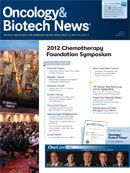Publication
Article
Novel Formulations and Molecular Characterization of AML Offer Hope and Complexity
Author(s):
Recent advances in the characterization of the molecular genetic defects underlying AML, as well as in novel formulations of therapies, are offering hope for improved outcomes.
Gail J. Roboz, MD
Despite advances in the treatment of acute myeloid leukemia (AML) over the last few years, survival of patients with the disease remains poor. However, recent advances in the characterization of the molecular genetic defects underlying AML, as well as in novel formulations of therapies, are offering hope for improved outcomes. In a presentation at the 2012 Chemotherapy Foundation Symposium, Gail J. Roboz, MD, associate professor of Medicine and director of the Leukemia Program at Weill Medical College of Cornell University in New York City, reviewed some of the AML therapies in later-stage development.
Traditionally, patient-specific factors—age, performance status, and comorbid illnesses—were used to determine disease prognosis, but those are giving way to leukemia-specific factors, including cytogenetics, single-gene mutations, antecedent hematologic disorders, and secondary AML as prognostic indicators. “Cytogenetics and mutational analyses are driving how we look at the disease,” Roboz said.
AML is now recognized as a genetically highly heterogeneous disease, and although that diversity presents the opportunity to categorize AML by distinct molecular subgroups—possibly with personalized treatments for the various mutations—it also presents a challenge in terms of drug development and clinical trials. “This is a disease of one name, but it’s many different diseases,” Roboz said. “When you’re thinking ahead about personalizing therapy…it’s going to be an awful lot of personalization and clinical trial development [to determine] how to make the therapeutic outcomes more than just anecdotal for two people with a particular set of mutations. It has to be quite carefully considered, and the construction of these personalized trials is not easy.”
The current treatment paradigm for AML is a very old one, Roboz noted, and comprises remission induction followed by consolidation with 1 to 4 cycles of chemotherapy or autologous or allogeneic stem cell transplant. Roboz highlighted a number of studies now under way that are aimed at improving the current treatment paradigm, including methods for optimizing the “7 + 3” induction regimen (7 days of cytarabine combined with 3 days of anthracycline or anthracenedione).
In a multicenter, randomized, phase III trial, 652 patients with untreated AML were randomized to one of three induction regimens: DA (daunorubicin plus cytarabine), DAC (DA plus cladribine), or DAF (DA plus fludarabine; J Clin Oncol. 2012;30[20]:2441- 2448). Compared with patients in the DA arm, patients who received cladribine had a higher rate of complete remission (67.5% vs 56%; P = .01) and an improved probability of overall survival (45% ± 4% at 3 years in the DAC arm vs 33% ± 4% in the DA arm; P = .02).
OncLive TV Exclusive
Dr. Gail Roboz on Improving the Standard Treatment of AML
Despite these encouraging results, Roboz said that few clinicians add cladribine to the treatment regimen. “This is one of the most perplexing things going on in AML—[this is] a big, randomized study with a clear benefit for cladribine, yet nobody does it.” The addition of cladribine, she added, might be something to consider down the road.
Other approaches seek to improve 7 + 3 with the use of novel formulations. CPX-351, for instance, is a liposomal formulation of cytarabine and daunorubicin in a 5:1 molar ratio.
Elacytarabine conjugates cytarabine with elaidic acid (a naturally occurring fatty acid). Elacytarabine is thought to bypass the transporter protein hENT1 in the leukemic cell membrane, thereby allowing for increased cellular uptake.
Novel agents are also under development, including vosaroxin, a first-in-class, anticancer quinolone derivative being studied in the phase III VALOR trial. Patients with first relapsed or refractory acute AML will be randomized to vosaroxin plus cytarabine versus placebo plus cytarabine. The primary endpoint is overall survival; the secondary endpoints are the complete remission rate and safety and tolerability.
Another late-stage trial is investigating the use of decitabine, a DNA demethylating agent, as an induction strategy for patients aged ≥60 years with acute AML. The phase II CALGB (Alliance) 11002 trial will look at “real-world” older AML patients, Roboz said. The study’s primary endpoint is overall survival, not the complete remission rate, which may indicate whether overall survival for this group of patients depends upon a complete remission.
Finally, two other novel therapies are in development: SGI-110, a dinucleotide of decitabine and deoxyguanosine that increases in vivo exposure/efficacy of decitabine by protecting it from elimination by cytidine deaminase; and oral azacitidine (AZA-008), now being studied in a phase III trial in AML postremission and for use posttransplant, Roboz said. (Azacitidine is approved as Vidaza for the treatment of all five French-American-British subtypes of myelodysplastic syndromes.)










